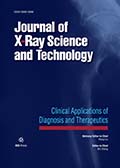Authors: Xu, Xianfeng | Li, Zhenzhou | Qiu, Xixiong | Wei, Zhaolian
Article Type:
Research Article
Abstract:
OBJECTIVE: This study aims to investigate the value of PET/CT scanning in preoperative diagnosis of cervical carcinoma, especially for detecting lymph node metastasis. MATERIALS AND METHODS: The approval of the ethics committee which was granted by our hospital was obtained beforehand. Patients with CC were collected into this investigation between January 2011 and October 2015. Each participant received surgeries, as well as pelvic and paraaortic systematic lymph node dissection. After operations, CC types were confirmed by pathological examinations. The tumor stages were assessed by 3 experienced radiologists independently, according to FIGO examinations and positron emission tomography-computed tomography
…(PET/CT), and these above diagnostic results were compared with postoperative biopsy pathology, respectively. Statistical analysis was done by SPSS 16.0, and the diagnostic performance of PET/CT was calculated. RESULTS: 51 patients were identified in this investigation, and the mean age of these female individuals was 42.3±6.7 years (range, 34–58 years). Depending on statistical analysis, the staging accuracy of PET/CT to detect primary tumors was 84.31%, with sensitivity 88.00% and specificity 80.77%. With respect to lymph nodes, the accuracy could reach 76.47%, with sensitivity 82.61% and specificity 71.43%. On the other hand, FIGO staging performed poorly in detecting primary tumors, with sensitivity 44.12%, specificity 47.06% and accuracy 45.10%. In terms of testing lymph nodes, the diagnosis parameters were as followed, sensitivity 28.57%, specificity 8.70% and accuracy 19.61%. After statistical analysis, there was significantly different between two methods (P < 0.05). CONCLUSIONS: PET/CT scanning may be valuable in detecting primary tumors and lymph nodes, and more accurate staging may lead to improving therapeutic planning in CC patients.
Show more
Keywords: Diagnosis, positron emission tomography-computed tomography, cervical cancer
DOI: 10.3233/XST-160569
Citation: Journal of X-Ray Science and Technology,
vol. 24, no. 4, pp. 531-536, 2016
Price: EUR 27.50





